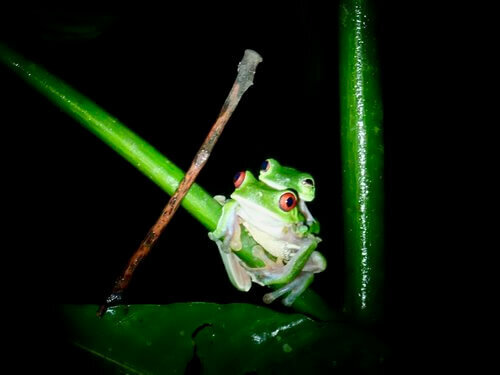A day in the life of a resident biologists
told by Rosa and Barley (Resident Biologists from the University of Cambridge)
Rosa and I both graduated from the University of Cambridge in 2018. She specialised in Social Anthropology and I in Plant Sciences. Next year Rosa is starting a MSc in Ethnobotany (the scientific study of the traditional knowledge and customs of a people concerning plants and their medical, religious, and other uses) and I will be beginning my PhD in Forestry Genetics at Oxford - from that I hope it is very clear to you that we are both fairly nerdy and delighted to be here surrounded by such amazing and diverse rainforest.
Our day begins with a 05:30 alarm which sounds horrible but is actually very easy to adjust to, as due to jet lag we were both waking up at 4 am when we first arrived. Screeching Scarlet Macaws, howling Monkeys and the general buzzing of the Rainforest also helps… The day here properly begins at 6am so we use the first half hour to wake up and to ring home as the time difference makes that the most convenient.
Between 6am and 7am we make and eat our delicious breakfast usually consisting of fresh papaya, homemade yogurt, a mix of cereals and coconut flakes. We also help out with setting the restaurant and checking the tides for the day.
7:30am marks the beginning of the school day. Simon and Chantelle moved to Costa Rica 3 years ago and they bravely brought with them their three children who they have been homeschooling ever since. All three children are studying the British curriculum with the eldest about to take his GCSES and youngest just starting secondary school. Rosa is focusing on teaching humanities and I on sciences. It's been a while since I started secondary school but I'm delighted to say that so far I've understood everything I'm teaching! The lessons are all very intense as they are 1 to 1 so we aim to finish school by midday. However, factoring in rescuing baby birds, a swim in the sea or a trip to see the neighbour’s horses means that midday is more of a guideline than an actual rule. Highlights of school so far have included using red cabbage as a pH indicator (it may shock you to hear that the rainforest doesn't have a shop selling universal indicator and litmus paper) and homemade games of pairs to help remember respiration.
For lunch we eat a mix of the fancy leftovers from the restaurant as well as traditional Costa Rican food such as fried plantain and Gallo Pinto (a mix of rice and black beans). After lunch a number of things could happen. Rosa and I are most likely to spend the afternoon with guests; taking them on an excursion of the rainforest or out to sea to see the mangroves or go snorkelling. There are so many different things on offer here that I can't really mention them all, but for me this place is most amazing because of its trees, so one of my favourite outing is the three hour trek to the waterfall with the amazing guide Augustine. He tells you all about the local uses for the plants you encounter, and if you're lucky you might spot the endemic Golfo Dulce poison dart frog. Despite Augustine and Rosa's assurances I think if I get bitten by a Fer-de-Lance I'd rather run to the hospital than chew on the nearest vine. Another highlight is accompanying guests kayaking through the mangroves and teaching them about the ecology of these incredible trees and the ecosystem they support. The cool dark quiet of the mangrove forest is very ethereal (or 'Just like jurassic park!' as a 11 year old guest recently declared) and it just amazes me that the trees have adapted to live in such harsh conditions.
We return from the excursion hopefully in time for tea and cake at 5pm! Gradually we have managed to infiltrate Chantelle's amazing baking and are now allowed to help, today we even made the lemon drizzle cake ourselves. As well as spending time on excursions there is also a nice amount of free time which we fill with: playing with the children (I'm in the process of teaching them to scuba dive in the pool), watching TV, browsing the internet, reading, learning Spanish and painting (slowly we are trying to do watercolours of all the orchids on the gardens).
Dinner is at around 7pm and Rosa the children and I always sit down to eat together. I cannot impress upon you enough how amazing the food is here I am genuinely worried about how angry my stomach will be when it has to return to being nurtured by a student's diet.
After dinner we help in clearing all the cushions and rugs from the restaurant and the living room. One of the downsides of the humid climate here is that mould grows in a matter of days if material is left unattended as my shoes and glasses case quickly discovered. That's a small price to pay for the optimal growing conditions leading to huge amounts of biodiversity. There is also the option of two excursions for guests after dinner: the night tour to look for frogs, snakes, turtles, caymans and insects in the nearby ponds which is always different and interesting no matter how many times you go. The other is the magical bioluminescence trip where you are taken out on the boat to swim in a sea which will literally light up around you as you swim through it. After that there's time for a quick shower before bed and then the cycle repeats again.




